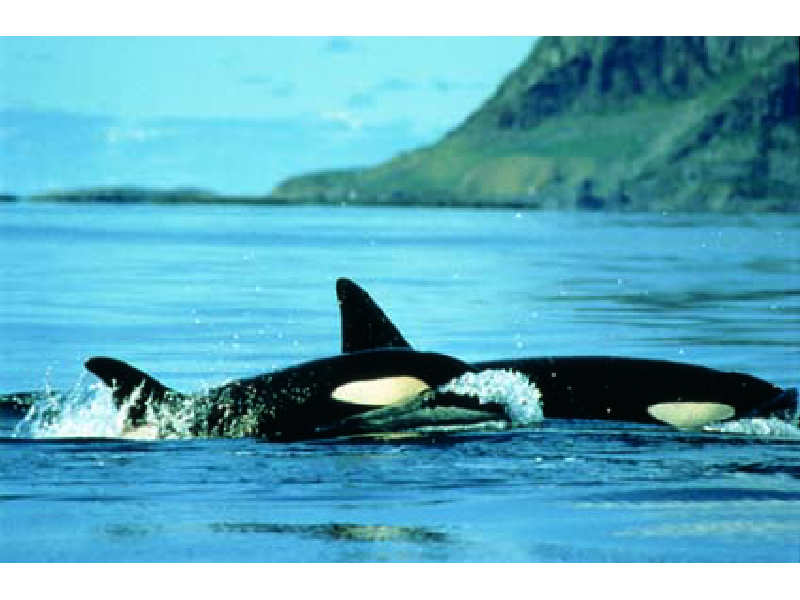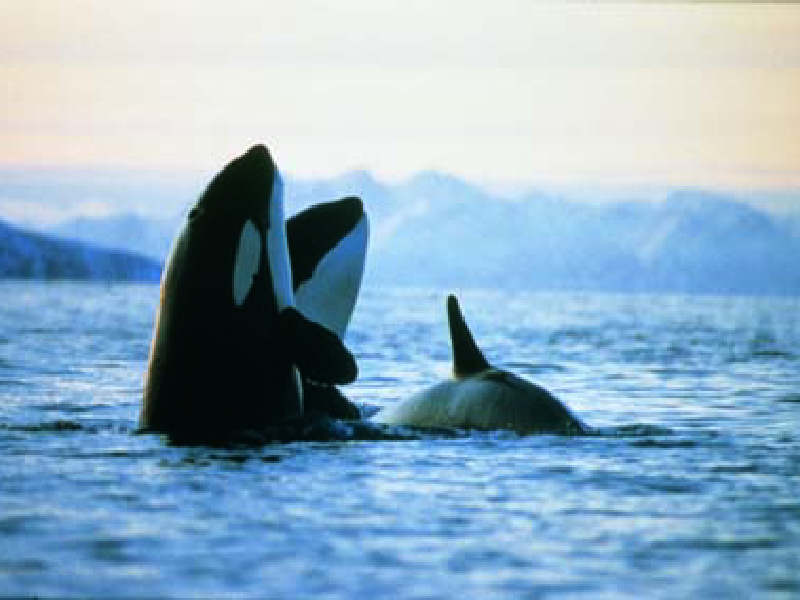Killer whale (Orcinus orca)
Distribution data supplied by the Ocean Biodiversity Information System (OBIS). To interrogate UK data visit the NBN Atlas.Map Help
| Researched by | John Bleach | Refereed by | Admin |
| Authority | (Linnaeus, 1758) | ||
| Other common names | - | Synonyms | - |
Summary
Description
Recorded distribution in Britain and Ireland
Shetlands, north and west Scotland. Irish coastline and south and west coasts of England and Wales.Global distribution
-Habitat
Usually found in deep water, although it may enter shallow water to catch prey.Depth range
-Identifying features
- Up to 9 m in length with a blunt snout.
- Distinctive black and white colouring, with white belly, throat and patch behind eyes.
- Large dorsal fin, up to 1.8 m high.
- Large paddle-like flippers.
Additional information
The orca is the largest species of dolphin. It is also referred to as the killer whale. It is a fast swimmer, reaching speeds in excess of 30 knots. It feeds on squid, octopus, fish, seals and other smaller dolphins and may eat seabirds and marine turtles occasionally.Orcinus orca is listed in the Red list of threatened animals (IUCN, 2003) as of Lower Risk (LR) but dependant on conservation effort. Orcinus orca is included within the grouped Species Action Plan "toothed whales (other than small dolphins)" under the UK Biodiversity Action Plan (Anon, 1999x). The killer whale is listed under Appendix II of the Bern convention. All species of cetaceans are given protection under the Wildlife & Countryside Act 1981 and the Wildlife (Northern Ireland) Order 1985 (Anon, 1999x). All cetacean species are listed on Annex IV (Animal and Plant Species of Community Interest in Need of Strict Protection) of the EC Habitats Directive (Anon, 1999x). All whales are listed on Annex A of EU Council Regulation 338/97 and therefore treated by the EU as if they are on CITES Appendix I thus prohibiting their commercial trade (Anon, 1999x).
Whaling is illegal in UK waters (Fisheries Act 1981) but neighbouring countries maintain the right to hunt (Anon, 1999x). An 'Agreement on the Conservation of Small Cetaceans in the Baltic and North Seas' (ASCOBANS), formulated in 1992, has now been signed by seven European countries, including the UK. Under the Agreement, provision is made for protection of specific areas, monitoring, research, information exchange, pollution control and heightening public awareness. Although aimed primarily at dolphins and porpoises, ASCOBANS includes all toothed whales except the sperm whale (Anon, 1999x). The killer whale is also listed on Appendix II of the Bonn Convention on the Conservation of Migratory species of Wild Animals (Anon, 1999x).Listed by
Bibliography
Anonymous, 1999. Toothed whales. Grouped Species Action Plan. http://www.ukbap.org.uk/UKPlans.aspx?ID=339, 2004-07-13
Bruyns, W.F.J.M., 1971. Field guide of whales and dolphins. Amsterdam: Publishing Company Tors.
Howson, C.M. & Picton, B.E., 1997. The species directory of the marine fauna and flora of the British Isles and surrounding seas. Belfast: Ulster Museum. [Ulster Museum publication, no. 276.]
Jefferson, T.A., Leatherwood, S. & Webber, M.A., 1994. FAO species identification guide. Marine mammals of the world. Rome: United Nations Environment Programme, Food and Agriculture Organization of the United Nations.
Reid. J.B., Evans. P.G.H., Northridge. S.P. (ed.), 2003. Atlas of Cetacean Distribution in North-west European Waters. Peterborough: Joint Nature Conservation Committee.
Datasets
Bristol Regional Environmental Records Centre, 2017. BRERC species records recorded over 15 years ago. Occurrence dataset: https://doi.org/10.15468/h1ln5p accessed via GBIF.org on 2018-09-25.
Cofnod – North Wales Environmental Information Service, 2018. Miscellaneous records held on the Cofnod database. Occurrence dataset: https://doi.org/10.15468/hcgqsi accessed via GBIF.org on 2018-09-25.
Environmental Records Information Centre North East, 2018. ERIC NE Combined dataset to 2017. Occurrence dataset: http://www.ericnortheast.org.ukl accessed via NBNAtlas.org on 2018-09-38
Hebridean Whale and Dolphin Trust, 2018. Visual sightings data set 2003-2017. Occurrence dataset: https://hwdt.org/ accessed via NBNAtlas.org on 2018-09-27.
John Muir Trust, 2017. Species Records for John Muir Trust Properties 2007-2009. Occurrence dataset: https://doi.org/10.15468/p5lw5z accessed via GBIF.org on 2018-09-27.
Manx Biological Recording Partnership, 2017. Isle of Man wildlife records from 01/01/2000 to 13/02/2017. Occurrence dataset: https://doi.org/10.15468/mopwow accessed via GBIF.org on 2018-10-01.
Manx Biological Recording Partnership, 2018. Isle of Man historical wildlife records 1995 to 1999. Occurrence dataset: https://doi.org/10.15468/lo2tge accessed via GBIF.org on 2018-10-01.
Merseyside BioBank., 2017. Merseyside BioBank (verified). Occurrence dataset: https://doi.org/10.15468/ar0p6s accessed via GBIF.org on 2018-10-01.
NBN (National Biodiversity Network) Atlas. Available from: https://www.nbnatlas.org.
Norfolk Biodiversity Information Service, 2017. NBIS Records to December 2016. Occurrence dataset: https://doi.org/10.15468/jca5lo accessed via GBIF.org on 2018-10-01.
North East Scotland Biological Records Centre, 2017. NE Scotland marine mammal records 1800-2010. Occurrence dataset: https://doi.org/10.15468/suphju accessed via GBIF.org on 2018-10-01.
OBIS (Ocean Biodiversity Information System), 2025. Global map of species distribution using gridded data. Available from: Ocean Biogeographic Information System. www.iobis.org. Accessed: 2025-07-01
Outer Hebrides Biological Recording, 2018. Vertebrates (except birds, INNS and restricted records), Outer Hebrides. Occurrence dataset: https://doi.org/10.15468/dax3tf accessed via GBIF.org on 2018-10-01.
The Mammal Society., 2017. National Mammal Atlas Project, online recording. Occurrence dataset: https://doi.org/10.15468/i2eosa accessed via GBIF.org on 2018-10-02.
Whale and Dolphin Conservation, 2018. WDC Shorewatch Sightings. Occurrence dataset: https://doi.org/10.15468/9vuieb accessed via GBIF.org on 2018-10-02.
Citation
This review can be cited as:
Last Updated: 16/10/2006




